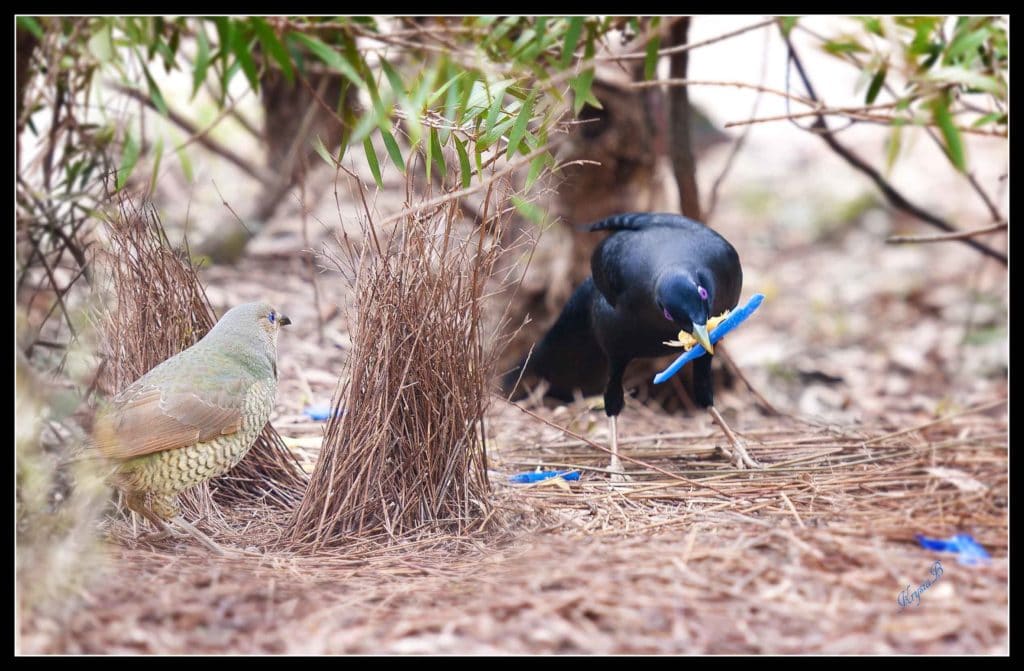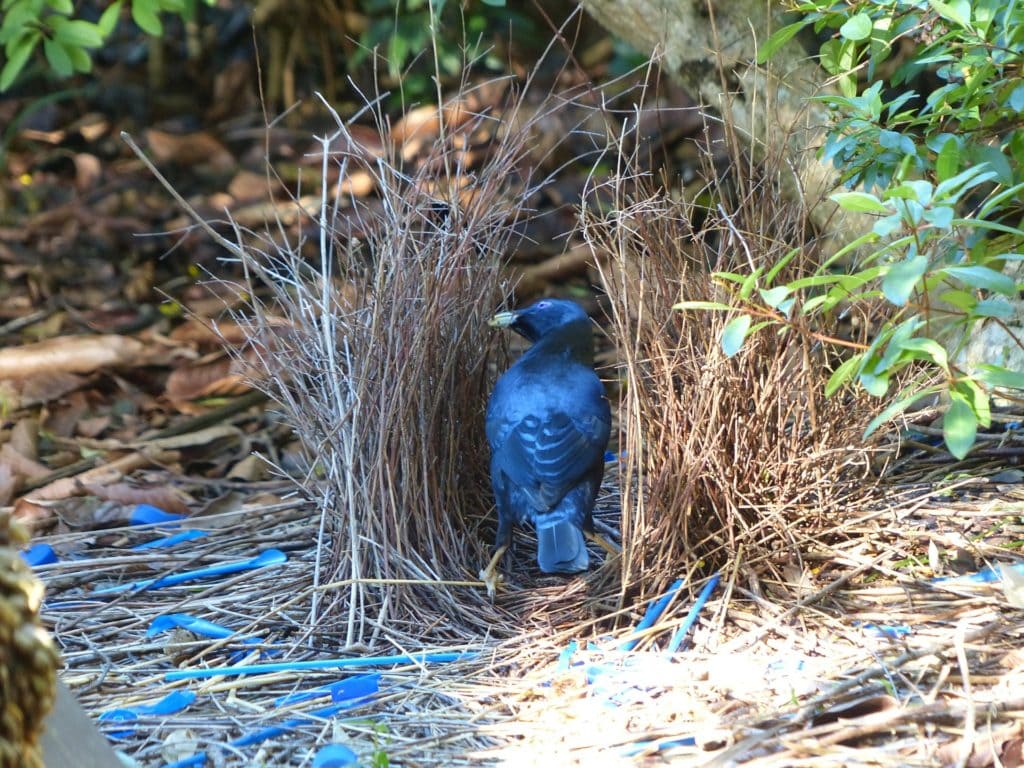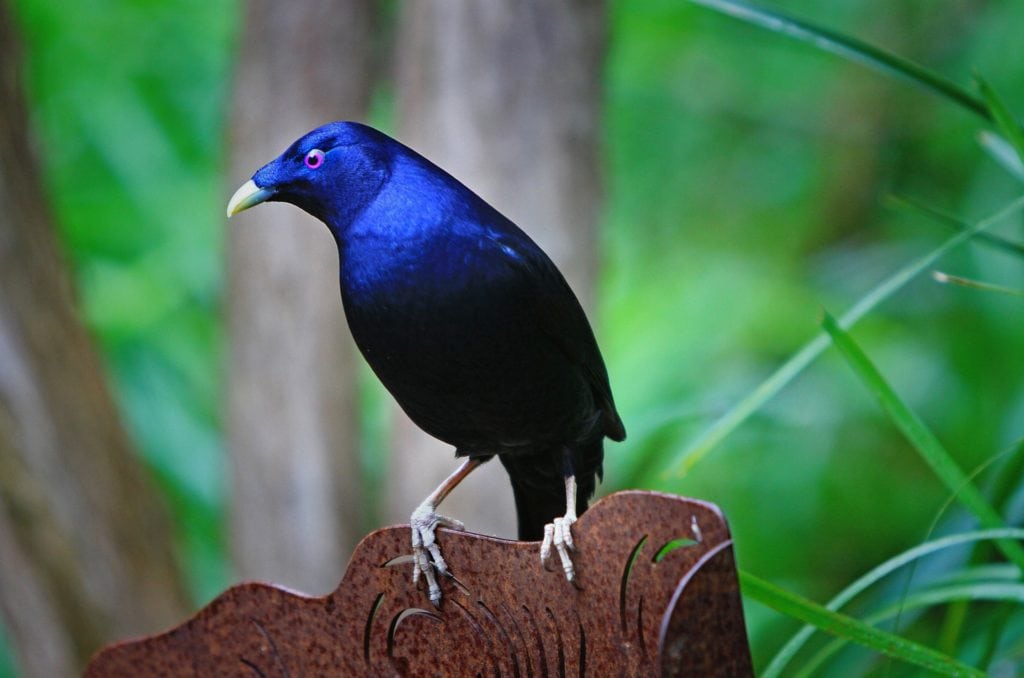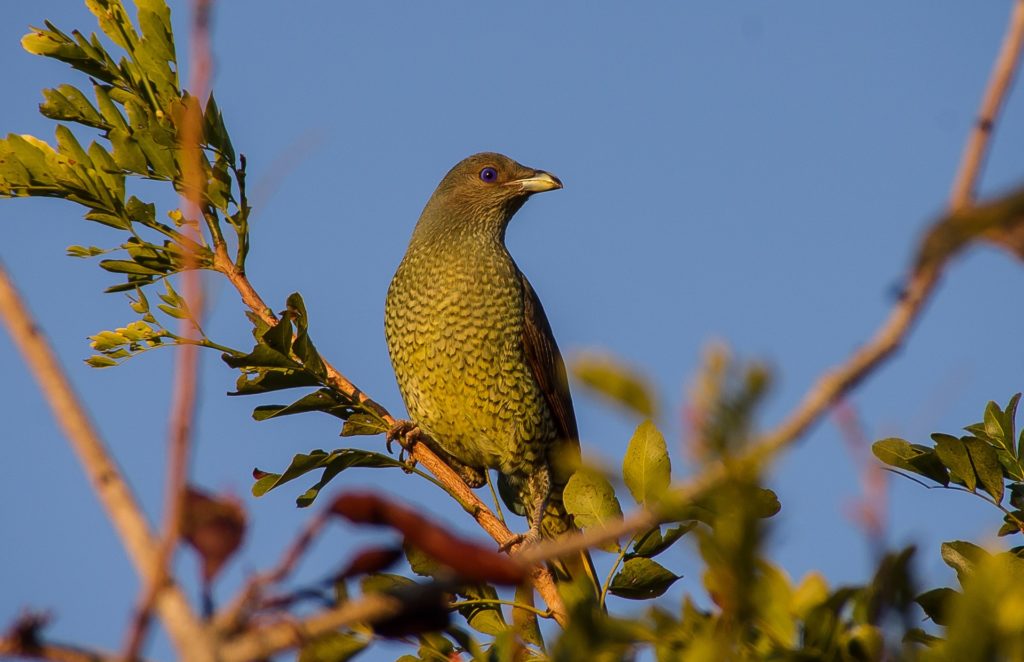Native to Australia and Papua New Guinea, the Bowerbird is a close relative of the Birds-of-Paradise. Bowerbirds are exceptional animals most famous for one very special talent. So special, in fact, is the Bowerbird’s talent that nineteenth century European explorers were certain that humans must be responsible for the Bowerbirds’ creations. (1)
Bowerbirds are so named for the elaborate constructions that males build in order to attract females. These “bowers” are structures designed to demonstrate the quality of the male Bowerbird and to catch the eye of females. Often, bowers are collections of sticks and twigs shaped into a number of different forms and adorned with shiny or colorful objects. The largest of bowers can exceed nine feet in height or six feet in diameter depending upon the vision of the avian architect behind the bower. (2)
Bowerbird Symbolism and Meaning
The amazing construction abilities of the Bowerbird are often touted as evidence of nonhuman ingenuity. Truly, this is inarguable. The precision, detail, and craftsmanship that some Bowerbird species exhibit is breathtaking. Without a doubt, the Bowerbird must be seen to represent intelligence, design, and creativity.
Often, the bowers of Bowerbirds are adorned with stolen man-made objects. For this reason, Bowerbirds are sometimes associated with thievery and covetousness. Many species, such as the Satin Bowerbird, show preferences for certain colors in their decorations. In the case of the Satin Bowerbird, blue objects are preferred for attracting the female’s eye. Bits of plastic and other human objects are perfect for this purpose because their colors do not fade and the objects do not decay. So, Satin Bowerbird bowers are littered, in a deliberate and precise fashion, with blue detritus. (3)

The genius of the Bowerbird does not stem from divine inspiration, or at least not without another stronger motivation. All of the Bowerbird’s incredible creative efforts are focused on a singular goal: to court a female, in some cases many females, and pass the male’s genes onto the next generation of Bowerbirds. Presumably, since females are discerning and only choose males who build eye-catching bowers, each generation is destined to be populated by even more talented builders than the last. (4)
So, the Bowerbird may represent courtship, romance, and competition.
Because some species of Bowerbirds decorate their bowers with fruit, the Bowerbird has inadvertently become one of the only non-human animals to propagate plants, and the only one to do so for reasons other than food. When the decorative fruits wither and fade, Bowerbirds discard them nearby the bower where they then grow into plants which provide even more decorative fruits. Some Bowerbirds even use fruit or vegetable juices to “paint” their bowers! (5) So, Bowerbirds may represent cultivation, foresight, and planning.
Finally, though they are most recognized for their impressive architectural feats, Bowerbirds have yet another talent. Capable of a range of cries, buzzes, whistles, and cackles, the vocal repertoire of the Bowerbird goes far beyond the normal range of bird calls. Bowerbirds are excellent mimics who have been found to mimic the cries of predatory birds, the barking of dogs, the sounds of mechanical equipment, and even human speech. (6)(7)
When it comes to the Bowerbird, it’s almost difficult to imagine something that these animals can’t do.
Bowerbird Native American Symbolism
Bowerbirds are not found in the Americas, but many of their traits can be seen in birds which do appear in Native American traditions. Mockingbirds, due to their ability to mimic sounds, are associated with cleverness in many Native tribes. Magpies, which are known to show curiosity and interest in human objects, are associated with trouble-making. It’s easy to imagine that the Bowerbird would be interpreted similarly. (8)(9)
Bowerbird Christianity Symbolism
Bowerbirds certainly do not, themselves, appear within the Bible’s pages. What is frequently discussed throughout the Bible is the idea of building one’s home. In the Bible, the home and household is the ultimate symbol of stability. Time and again, the faithful are urged to build their metaphorical homes in accordance with the will of God and so enjoy prosperity and stability. The passage which most reminds me of the Bowerbird is Proverbs 24:3-4:

“Through wisdom a house is built,
And by understanding it is established;
By knowledge the rooms are filled
With all precious and pleasant riches.” (10)
Bowerbirds dedicate their lives to building structures and filling them with “treasures.” One might look to these birds as a reminder that a happy life begins at home.
Bowerbird Celtic Symbolism
In some Celtic traditions, fairies are thought to construct tiny magical structures which are sometimes called “Fairy Bowers.” These locations are thought to be gateways to the supernatural and humans are warned not to disturb them. So, perhaps the Bowerbird might be a member of the fairy folk! (11)
Bowerbird in Dreams
Dreaming of the Bowerbird is a sign that one is brimming with creative energy. Perhaps your greatest masterpiece is just around the corner? The Bowerbird appears in dreams to remind us that creativity appears in all shapes and sizes. Sure, art often looks like detailed paintings or lifelike sculptures, but who could see the bold colors collected by the Bowerbird as anything but the work of a great artist? If you’ve been dreaming of the Bowerbird, do your best to express yourself authentically and create the kind of art which makes you happy.
Bowerbirds build their brilliant bowers as a means of showcasing their skill to attract the opposite sex. Dreaming of a Bowerbird may suggest romantic turmoil or jealousy. You may feel like you need to “show off” in order to impress the one you desire. Remember, though, that the Bowerbird’s display is far from superficial. Instead of showcasing strength or looks, the Bowerbird showcases its ingenuity. So, try to showcase your authentic self and highlight your true strengths. Anyone who you really want to be with would appreciate the real you.
Bowerbird Encounters and Omens
Encountering a Bowerbird is unlikely unless you live in Australia and New Guinea. Even in those regions, many species of Bowerbird are found only in remote tracts of rainforest. Still, some Bowerbirds, like the Satin Bowerbird, are frequently spotted by humans. (12) In any case, whether you’ve seen a Bowerbird in person, stumbled upon a bower, or simply keep encountering images of the Bowerbird online, this bird is nonetheless impactful.
Encountering a Bowerbird is a great opportunity to assess oneself and one’s chosen path. The Bowerbird spends its life honing its craft and bringing beauty, order, and vibrant colors to its own little patch of rainforest. A Bowerbird encounter can cause one to think about one’s own home environment. Do the things with which you surround yourself bring you joy? Do they reflect the truth of your personality? Is your home a place of comfort and expression? The Bowerbird reminds you that your environment is what you make of it.

Bowerbird in Mythology & Folklore
In some Aboriginal traditions, Bowerbirds are called “Ghost Birds” because bones are occasionally used as construction materials for their bowers. These birds are only found in Australia and New Guinea, so they do not otherwise appear in mythology however I have included below an Aboriginal Australian “Dreamtime” legend which features the Bowerbird.
Aboriginal Mythology:
One Aboriginal “Dreamtime” story describes how many different birds obtained their feature. According to this tale, long before there were animals or regular people, a tribe of six men and one elderly woman lived in a village with a single kangaroo. Each day the old woman would gather herbs to eat but would not share with the men who had nothing to eat but sugarcane. One day, while the woman was foraging, the men decided that they would try to catch and eat the kangaroo. So, five of the men went hunting leaving behind a man named Bowerbird who had a boil on his foot and couldn’t walk with them. When the wily kangaroo saw the foolish band of hunters, he knew they could never catch him so he simply hopped away. The men were determined though, so they asked their wise friend Bowerbird to help. Bowerbird agreed to help only if one of them would pop the boil on his foot. Each man tried, but only Crow was strong enough to accomplish this. Popping the boil turned crow’s eyes yellow, and the crows of Australia have yellow eyes to this day. (12)
Not realizing that a new hunter had joined them, the kangaroo remained unafraid of the hunting party. So, Bowerbird managed to pounce on the kangaroo and the party began carrying their dinner back to camp. There, they started to cook the kangaroo, but with each bite they took the men began transforming into birds. Crow became a crow, Rosella became a Rosella Parrot, and Bowerbird became a Bowerbird. Desperate to keep eating, the men snatched at the hot meat on the fire which singed their feathers and gave them their respective colors. Rosella was seared red while Bowerbird was burnt black. (13)
Bowerbird Spirit Animal
If the Bowerbird is your spirit animal then you are most likely outgoing, creative, expressive, intelligent, and thoughtful. People with the Bowerbird as their spirit animal are dedicated to the lifelong mission of self expression. For someone with this spirit animal, fitting in with the crowd is easy but not at all desirable. The Bowerbird spirit animal can blend in with others but loathes to do so. Instead, this spirit animal chooses to stake its claim in the world by standing out and expressing its inner self as much as possible.
People with the Bowerbird spirit animal tend to be intense and driven. Obsessed with creating things that perfectly capture their innermost selves, Bowerbird spirits are prone to perfectionism. This artistic intensity can be off-putting to some and can be self-destructive as well. For this reason, the Bowerbird spirit must find ways to accept life’s little imperfections as part of their art.
Bowerbird Totem Animal
The Bowerbird totem animal is associated with homemaking. Long connected with so-called “house wives,” homemaking is a genderless pursuit which involves household management, chores, and upkeep. The Bowerbird totem animal helps bring individuality, openness, and welcoming energy into one’s home.
As humans, we spend much of our lives cloistered within our homes. Our environments can be prisons if we do not treat them correctly. The proper management of one’s home environment is a vital skill which leads to many happy returns. The Bowerbird totem animal sees homemaking as art in itself and pursues this practice with energy and enthusiasm. For the Bowerbird totem, decorating the home with treasured objects and heartfelt memories is as much a masterpiece as any traditional art form.

Bowerbird Power Animal
The power of the Bowerbird is ingenuity. Nobody knows exactly why these exceptional jungle birds developed their bower-building habits. What we do know is that over the course of the Bowerbird’s evolution, a line was crossed between simple structures and truly inspired displays of competence and resourcefulness. The Bowerbird power animal reminds you that solutions are all around you. Where most would see random scraps of refuse, the Bowerbird sees the medium with which its bower can be decorated and elevated.
Figuring out novel uses for the tools available to you is one of the hallmarks of a genius. When you are backed into a corner, look at all of your options and count upon the Bowerbird power animal to inspire you and guide your thoughts towards new solutions.
Bowerbird Tattoo Meaning
A Bowerbird tattoo may be chosen by someone with a hobby that involves collecting things. Because of their bower decorations, Bowerbirds are often associated with the urge to collect.
A Bowerbird tattoo may also represent architecture, creativity, stability, resourcefulness, or courtship.
A tattoo of a Bowerbird’s bower might be chosen to represent the fact that great things can be accomplished by even the most unlikely of creatures. The Bowerbird may not look like much, but some species’ bowers tower above most people’s heads.
Conclusion
It’s easy to imagine why nineteenth century European explorers thought that Bowerbird bowers must have been human constructions when they first encountered these marvels. The Bowerbird is a testament to the intelligence and creative capacity of non-human animals. This is a concept which human scientists have only really begun to explore in the last several decades. In that time, primates have largely been hailed as the kings of cognition. In recent years, though, more and more birds have begun filling the ranks of the “smart animals.” As our relationship with birds evolves and our understanding of their intellect deepens, my admiration for these incredible animals can only grow. The Bowerbird is a genius and a masterful artist. I wonder how many more of those exist amongst our avian neighbors.
